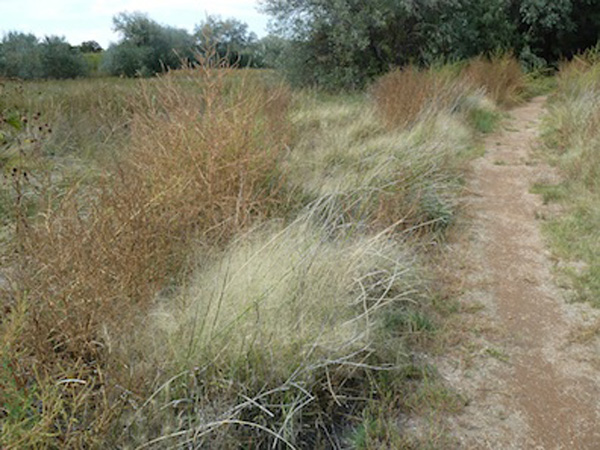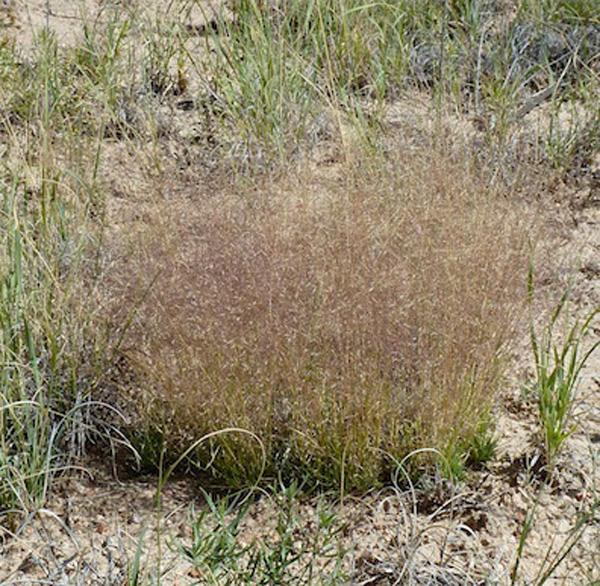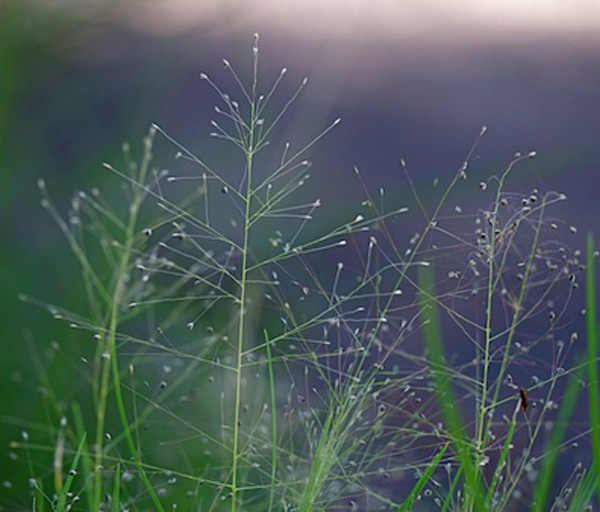Scientific name: Muhlenbergia asperifolia
Common name: alkali muhly
Family: Poaceae
Article by Susan Bruneni

Muhlenbergia asperifolia (Photo by Janice Tucker)
Visitors to Leonora Curtin Wetland Preserve always marvel at the late summer and early fall color. This year many were displaying photos and raving about the showy pink grasses along the main path. Use of adjectives like fairy plants, pink haze and mist, and “just like clouds at sunset” were some of the few exclamations. This perennial monocot grass is Muhlenbergia asperifolia. It is also very noticeable along Artist Road on the way to the Ski Basin.
The pink color is created by massive tiny purple blooms. By mid-October the blooms have disappeared and the “fairy clouds” have assumed the white/tan color of the seeds.
Muhlenbergia asperifolia is a species of grass known by the common names alkali muhly and scratch grass. It is native to much of North America, including most of southern Canada, most of the continental United States except for the southeastern region, and parts of northern Mexico.

Muhlenbergia asperifolia (Photo by Janice Tucker)
Alkai muhly is a rhizomatous perennial grass growing in thick clumps up to two feet tall. The inflorescence is a very open, wispy array of many hair-thin, outstretched branches each up to six inches long. The spikelets at the tips of the branches are less than two millimeters long.
Muhlenbergia asperifolia is a valuable grass for habitat restoration and revegetation projects in disturbed habitat in the southwest United States, especially in riparian zones in California and the Intermountain West. Once established and often grown with other grasses, it will create a dense groundcover.
A beautiful native grass and drought tolerant- there is no denying this grass has a great combination of traits. In tough landscapes and the garden setting it will thrive. Of the 70 species listed on the USDA plant database, Muhlenbergia asperifolia is one of the most dramatic. Growers often carry a similar species, M. capillarias or pink muhly, the cultivar ‘White Cloud’ and others suitable for home landscapes. All appreciate well-drained soil and sun. If planting in the fall, they should be in the ground by first frost.

Muhlenbergia asperifolia (Photo by Janice Tucker)
They often grow in arid or semiarid regions, with adaptations that make them a good choice for low-water landscapes. This also means they need well-drained soil to remain healthy and survive wet winters. They need full sun and dry conditions to look their best, and may suffer in shade or wet summers.
Muhlenbergia was named after one of the first early-American scientists, Lutheran minister and self-taught botanist, Gotthilf Henry Ernest Muhlenberg (1753-1815). He became interested in botany while hiding from British soldiers during the Revolutionary War. Muhlenberg was one of the early members of the American Philosophical Society (APS), the first scientific association in the New World, founded by Benjamin Franklin, John Bartram, and others. Many of Muhlenberg’s herbaria now reside in the collections of the Academy of Natural Sciences of Drexel University in Pennsylvania.
References:
“Muhlenbergia asperifolia (scratchgrass)”. USDA, NRCS. 2018. The PLANTS Database (http://plants.usda.gov, 25 October 2018). National Plant Data Team, Greensboro, NC 27401-4901 USA.
“Muhlenbergia asperifolia”. Wikipedia. Wikimedia Foundation. 1 Aug. 2018. Web. 25 Oct. 2018. Retrieved from: https://en.wikipedia.org/wiki/Muhlenbergia_asperifolia.
“Muhlenbergia asperifolia (scratch grass)”. Jepson eFlora. The Jepson Herbarium. University of California, Berkeley. Web. 25 Oct. 2018. Retrieved from: http://ucjeps.berkeley.edu/eflora/eflora_display.php?tid=34061.
“Muhlenbergia capillaris“. Hoffman Nursery, Inc. Web. 25 October 2018. Retrieved from: http://hoffmannursery.com/plants?search=Muhlenbergia+capillaris.


